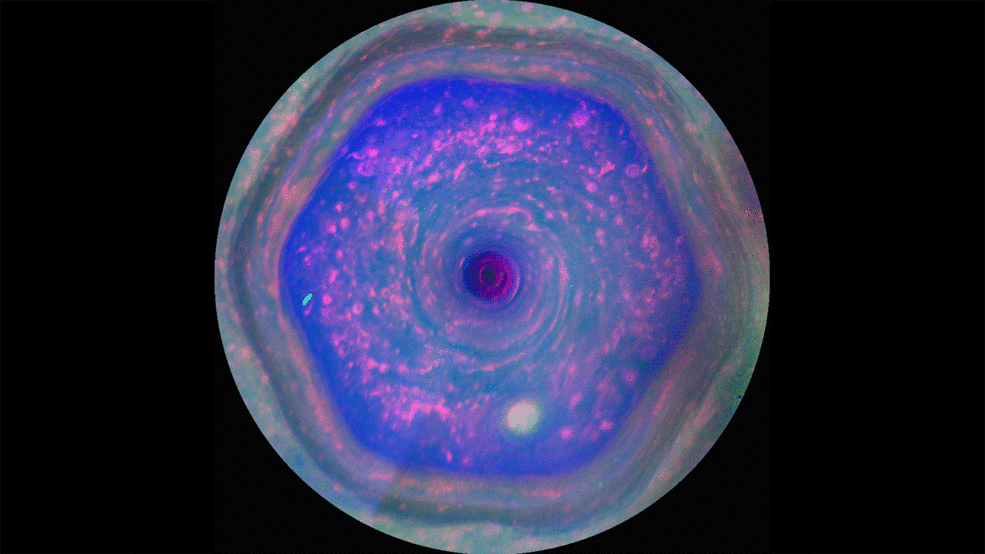A new long-term study using data from NASA's Cassini spacecraft has revealed a surprising feature emerging at Saturn's northern pole as it nears summertime: a warming, high-altitude vortex with a hexagonal shape, akin to the famous hexagon seen deeper down in Saturn's clouds.
How the next generation of ground-based super-telescopes will directly observe exoplanets
Over the past few decades, the number of extra-solar planets that have been detected and confirmed has grown exponentially. At present, the existence of 3,778 exoplanets have been confirmed in 2,818 planetary systems, with an additional 2,737 candidates awaiting confirmation. With this volume of planets available for study, the focus of exoplanet research has started to shift from detection towards characterization.
Health Check: what are nightshade vegetables and are they bad for you?
Hubble observes energetic lightshow at Saturn’s north pole
Astronomers using the NASA/ESA Hubble Space telescope have taken a series of spectacular images featuring the fluttering auroras at the north pole of Saturn. The observations were taken in ultraviolet light and the resulting images provide astronomers with the most comprehensive picture so far of Saturn’s northern aurora.
Telescope pierces into one of the biggest nebulae in the milky way to reveal its newly forming (and nearly dying) stars
Located about 7500 light-years from Earth, in the constellation of Carina, lies a star-forming region known as the Carina Nebula. This dynamic, evolving cloud of interstellar gas and dust measures about 300 light-years in diameter and is one of the Milky Way’s largest star-forming regions. It is also an exercise in contrasts, consisting of bright regions of gas illuminated by intense stellar radiation and dark pillars of dust that obscure star formation.
Math shows how DNA twists, turns and unzips
Building bricks on the moon from lunar dust
In the coming decades, many space agencies hope to conduct crewed missions to the Moon and even establish outposts there. In fact, between NASA, the European Space Agency (ESA), Roscosmos, and the Indian and Chinese space agencies, there are no shortages of plans to construct lunar bases and settlements. These will not only establish a human presence on the Moon, but facilitate missions to Mars and deeper into space.
The hidden costs of a hangover
Ten strategies to lose weight – backed by research
Everybody knows that to lose weight you should eat less and move more. But, of course, it’s not that simple; the combination of today’s environment and human biology can make it really, really hard to shed pounds. To reduce diseases caused by being overweight or obese, society needs to change, but those changes will be slow to come. We need effective weight-loss strategies now.
Hubble’s Lucky Observation of an Enigmatic Cloud
The little-known nebula IRAS 05437+2502 billows out among the bright stars and dark dust clouds that surround it in this striking image from the Hubble Space Telescope. It is located in the constellation of Taurus (the Bull), close to the central plane of our Milky Way galaxy. Unlike many of Hubble’s targets, this object has not been studied in detail and its exact nature is unclear.
How a NASA Scientist Looks in the Depths of the Great Red Spot to Find Water on Jupiter
For centuries, scientists have worked to understand the makeup of Jupiter. It’s no wonder: this mysterious planet is the biggest one in our solar system by far, and chemically, the closest relative to the Sun. Understanding Jupiter is key to learning more about how our solar system formed, and even about how other solar systems develop.
Why you can smell rain
15 of Spitzer's Greatest Discoveries From 15 Years in Space
There are so many water-worlds out there
Ever since the first exoplanet was confirmed in 1992, astronomers have found thousands of worlds beyond our Solar System. With more and more discoveries happening all the time, the focus of exoplanet research has begun to slowly shift from exoplanet discovery to exoplanet characterization. Essentially, scientists are now looking to determine the composition of exoplanets to determine whether or not they could support life.
Just Another Day on Aerosol Earth
Take a deep breath. Even if the air looks clear, it is nearly certain that you will inhale millions of solid particles and liquid droplets. These ubiquitous specks of matter are known as aerosols, and they can be found in the air over oceans, deserts, mountains, forests, ice and every ecosystem in between.
Health Check: why do I get a headache when I haven’t had my coffee?
Oort clouds around other stars should be visible in the cosmic microwave background
For decades, scientists have theorized that beyond the edge of the Solar System, at a distance of up to 50,000 AU (0.79 ly) from the Sun, there lies a massive cloud of icy planetesimals known as the Oort Cloud. Named in honor of Dutch astronomer Jan Oort, this cloud is believed to be where long-term comets originate from. However, to date, no direct evidence has been provided to confirm the Oort Cloud’s existence.
Research Check: can sleeping too much lead to an early death?
Why the summer sound of noisy crickets is growing fainter
Designed to deceive: How gambling distorts reality and hooks your brain
To call gambling a “game of chance” evokes fun, random luck and a sense of collective engagement. These playful connotations may be part of why almost 80 percent of American adults gamble at some point in their lifetime. When I ask my psychology students why they think people gamble, the most frequent suggestions are for pleasure, money or the thrill.












